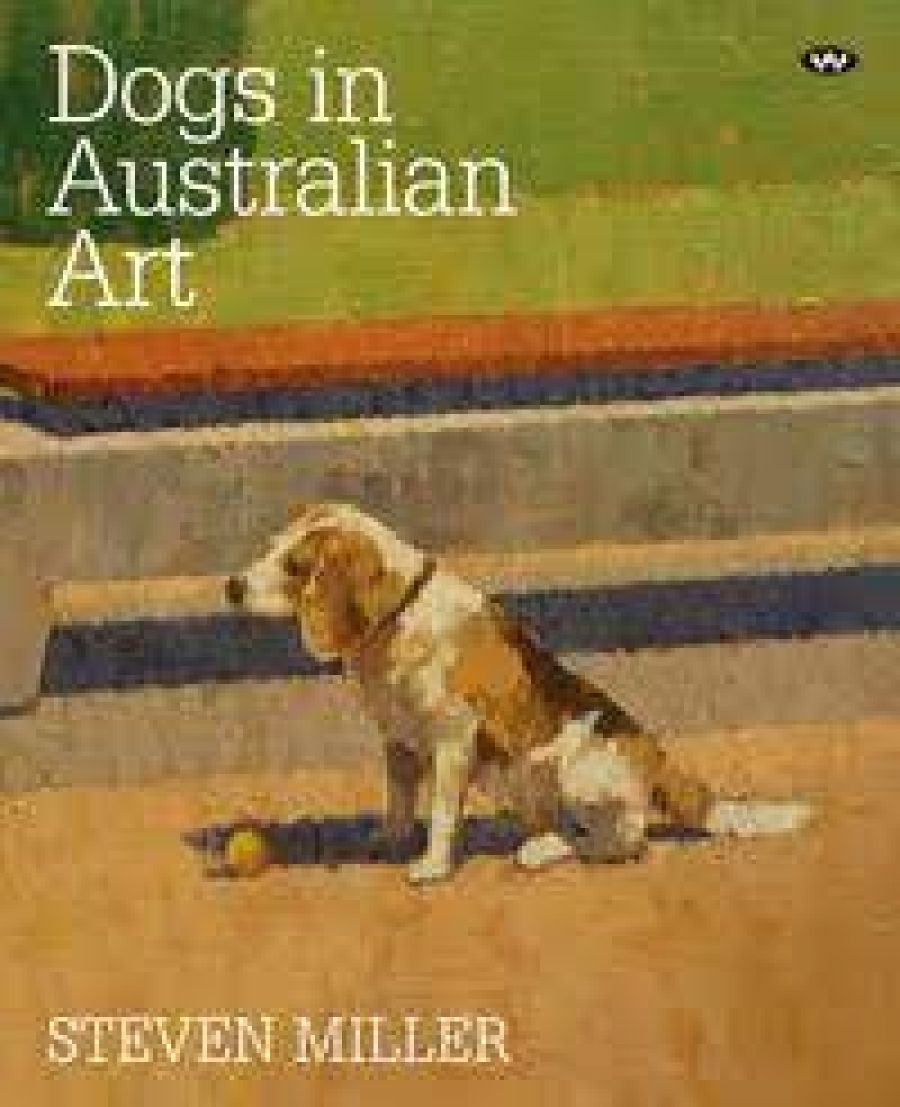
- Free Article: No
- Contents Category: Art
- Review Article: Yes
- Online Only: No
- Custom Highlight Text:
‘As cats are often associated with bookshops, dogs are similarly attracted to art galleries’, according to Steven Miller, head of the research library and archive of the Art Gallery of New South Wales, and author of Dogs in Australian Art: A New History in Antipodean Creativity. The beagle on the cover sits attentively, head slightly cocked, as if contemplating art. It is not until you turn the book over that you see what the dog is really looking at. David Welch’s wry painting sets the tone for this quirky and intriguing book.
- Book 1 Title: Dogs in Australian Art
- Book 1 Subtitle: A New History in Antipodean Creativity
- Book 1 Biblio: Wakefield Press, $39.95 pb, 200 pp
If dogs love art, art definitely loves dogs, as numerous books and exhibitions attest. Most recently, in Australia, the 2008 show Who Let the Dogs Out: The Dog in Contemporary Australian Art (Lake Macquarie City Art Gallery and the Hazelhurst Regional Gallery and Arts Centre). In Dogs in Australian Art, Miller goes further, positioning dogs as the protagonists of ‘the untold story of Australian art’.
Were it not for his dog Jemmy, Augustus Earle might never have strayed from the boat and been abandoned on the desolate island of Tristan da Cunha until he was picked up by a passing ship bound for Australia. Like many artists, William Dobell found much-needed companionship in his dogs. Miller suggests that even when dogs do not explicitly figure in Dobell’s paintings, a dog hair in the paint is a sign of authenticity.
Dogs can be found behind, beside, and in front of artists throughout history, and Miller proposes that they ‘can be a useful lens through which to view a tradition. The landscape, history, mythology, portraiture, these have all been used in this way. Why not the dog?’ The dogs in Miller’s witty revisionist Australian art history inhabit all these artistic spaces and more; from the iconic to the idiosyncratic; from the canvases of Russell Drysdale, Arthur Boyd, and Peter Booth to the embroidered portraits of Adrienne Doig (Miller makes a cameo in one with his pet terrier) and the edible sculptures of Janet Tavener, ‘who has illustrated more purebred [or should that be pure bread] dogs than any other Australian artist’ … in gingerbread.
Miller’s argument is set out in an introductory essay, and the remainder of the book is organised by breed, with one key work used to illustrate each breed. In most cases, this novel approach sees equal emphasis placed on the history of the breed, its arrival in Australia, its cultural influence, and its appearance in art, as on the featured artist and work, thus reinforcing Miller’s argument by demonstrating the broader significance of dogs in Australian life. However, it also serves to constrain the selection and sometimes the interpretation of the works of art presented.
 Mervyn Napier Waller (1893–1972) Christian Waller with Baldur, Undine and Stren and Fairy Hills, 1932 Oil and tempera on canvas mounted on composition board. 121.5 x 205.5 cm. (National Gallery of Australia)
Mervyn Napier Waller (1893–1972) Christian Waller with Baldur, Undine and Stren and Fairy Hills, 1932 Oil and tempera on canvas mounted on composition board. 121.5 x 205.5 cm. (National Gallery of Australia)
Five artists are represented by more than one work, while many worthy artists are omitted. Meanwhile, American artist Jeff Koons and his giant floral puppy are featured not once but twice in the book. Indigenous art is almost completely absent, with the exception of Lin Onus’s dingoes.
Dingoes may have been the only canines introduced to Australia prior to colonisation, when Miller’s story begins, but they are not alone in contemporary Aboriginal art. Where, for instance, are Lena Yarinkura’s cheeky mongrel camp dogs made from pandanus and ochre? There is no place for the mongrel in Miller’s catalogue of breeds, even though sometimes breeds can be very difficult to identify in art, as he acknowledges. Yet the author insists upon them, filing Geoff Harvey’s Boris (1999), with his chair leg limbs and bike seat head, under I for Ibizan Hound.
On balance, Dogs in Australian Art is an original, effective, and thoroughly enjoyable book with wide appeal, if not a major new Australian art history. It is well illustrated and elegant, modest in format, if not ambition. The alphabetical catalogue of breeds makes it attractive as a reference book, as well as an engaging read. Miller’s argument is bold and appealing, his observations and anecdotes apt and imaginative, though the book’s structure is at times problematic and limiting.


Comments powered by CComment